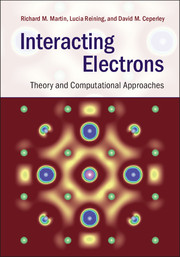Book contents
- Frontmatter
- Dedication
- Contents
- Preface
- Acknowledgments
- Notation
- Part I Interacting electrons: beyond the independent-particle picture
- Part II Foundations of theory for many-body systems
- Part III Many-body Green's function methods
- Part IV Stochastic methods
- 22 Introduction to stochastic methods
- 23 Variational Monte Carlo
- 24 Projector quantum Monte Carlo
- 25 Path-integral Monte Carlo
- 26 Concluding remarks
- Part V Appendices
- References
- Index
25 - Path-integral Monte Carlo
from Part IV - Stochastic methods
Published online by Cambridge University Press: 05 June 2016
- Frontmatter
- Dedication
- Contents
- Preface
- Acknowledgments
- Notation
- Part I Interacting electrons: beyond the independent-particle picture
- Part II Foundations of theory for many-body systems
- Part III Many-body Green's function methods
- Part IV Stochastic methods
- 22 Introduction to stochastic methods
- 23 Variational Monte Carlo
- 24 Projector quantum Monte Carlo
- 25 Path-integral Monte Carlo
- 26 Concluding remarks
- Part V Appendices
- References
- Index
Summary
It is shown from first principles that, in spite of the large interatomic forces, liquid 4He should exhibit a transition analogous to the transition in an ideal Bose–Einstein gas. The exact partition function is written as an integral over trajectories, using the space-time approach to quantum mechanics.
R.P. Feynman, 1953Summary
In this chapter we discuss imaginary-time path integrals and the path-integral Monte Carlo method for the calculation of properties of quantum systems at non-zero temperature. We discuss how Fermi and Bose statistics enter, and how to generalize the fixed-node procedure to non-zero temperature. We then discuss an auxiliary-field method for the Hubbard model. The path-integral method can be used to perform ground-state calculations, allowing calculations of properties with less bias than the projector Monte Carlo method. We also discuss the problem of estimating real-time response functions using information from imaginary-time correlation functions.
In previous chapters we described two QMC methods, namely variational QMC and projector (diffusion) QMC. Both of these methods are zero temperature, or, more properly, are formulated for single states. In this chapter we discuss the path-integral Monte Carlo (PIMC) method, which is explicitly formulated at non-zero temperature. Directly including temperature is important because many, if not most, measurements and practical applications involve significant thermal effects. One might think that to do calculations at a non-zero temperature we would have to explicitly sum over excited states. Such a summation would be difficult to accomplish once the temperature is above the energy gap, because there are so many possible many-body excitations. In addition, the properties for each excitation are more difficult to calculate than those for the ground state. As we will see, path-integral methods do not require an explicit sum over excitations. As an added bonus, they provide an interesting and enlightening window through which to view quantum systems. However, the sign problem, introduced in the previous chapter, is still present for fermion systems. The fixed-node approximation is used again.
An advantage of PIMC is the absence of a trial wavefunction. As a result, quantum expectation values, including ones not involving the energy, can be computed directly. For the expert, the lack of an importance function may seem a disadvantage; without it one cannot push the simulation in a preferred direction.
- Type
- Chapter
- Information
- Interacting ElectronsTheory and Computational Approaches, pp. 644 - 673Publisher: Cambridge University PressPrint publication year: 2016



